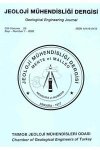
ABSTRACT: Reliable estimation of three dimensional hydraulic conductivity and effective porosity in an aquifer is particularly important to determine the site and depth of groundwater production wells. Three dimensional distribution of hydraulic conductivity and effective porosity in Mersin-Tarsus hillside and coastal aquifers that characterize delta-flood plain sedimentary system, was estimated by means of block kriging method. Validity of models in selecting appropriate drilling sites was demonstrated by the high correlation obtained between observed and calculated values. High and low values of hydraulic conductivity and effective porosity` are observed in close proximity of streams and distal fields, respectively.
ABSTRACT: Cities, which are established on sea cliffs, like Antalya, suffer some instability problems. The most important reason of cliffi nstability is wave erosion. At the base of cliffs wave impacts results in erosion. In thinly bedded rocks, this removes the support at the base and above rock layers fail due to high tensional stress. Cliff retreat is observed as a result of rockfall. Instead, in massive rocks, notches are developed at the base of the cliff. As a result ofu ndercutting tensional cracks occur above the cliff. This is the beginning of "tilt instability As the rock block is tilting, notch tends to be closed and turn in to a "crash zone ". As centre of gravity shifts through the sea, deformation increases in the crash zone, and additional deformation in the crash zone result in a new shift ofc entre of gravity. This process continues until the toppling of rock block completely. The process between opening of tension crack and toppling is called secondary toppling mechanism . Factors affecting rate of cliff erosion and retreat are; sediment transportation, wave direction and intensity, properties of rock material and rock mass, precipitation, urbanization and construction facilities. In this paper, erosion and retreat mechanism observed in Antalya sea cliffs will be explained. Erosion and retreat conditions of cliffs around A tat ürk Park. School of health. Yacht harbour-Iskele Street, Old Lara Street and Bambus Beach will be explained as case studies.
ABSTRACT: İn this study, detailed geology`, mineralogy, alteration ofs karn deposits in Çambaşı (Ordu) and Dereli (Giresun) areas were investigated and compared. In the studied area, two types of exoskarns were identified as garnet-pyroxene and epidote skarns. Mineralogy and mineral chemistry of these skarn zones were investigated. Garnets in Çambaşı (Ordu) skarn deposits are grossular-andradite (GrSfwo 43~^r0.06-0.56^ whereas in the Dereli (Giresun) area pure andradite and grossular-andradite (Adr0 47.0 996^0.0(1-0. $/). The clinopyroxenes in Çambaşı (Ordu) and Dereli (Giresun) areas, are classified as diopside. It was found out that the correlation between the composition of garnets and clinopyroxenes related to metal that skarn contains. The compositional distubution of the garnets and clinopyroxenes in the studied areas display a distribution pattern similar to garnets and clinopyroxenes from world-class Fe-Cu skarn.
ABSTRACT: High mountain ranges with perennial streams characterize the Eastern Anatolia. The northern pushing effect of the Arabian plate uplifts the region. Due to the high erosion rate barren topography dominates. Huge landslides take place where weak to extremely weak rocks are available. Outslope condition escalates the formation of immensely wide landslides. The proposed system: (1) stabilizes landslides and provides fertile farm land. (2) transfers the barren lands to irrigable gardens. (3) impedes flooding and (4) provides renewable energy.
ABSTRACT: Antalya Tufa plateaus, on which Antalya city established, cover 630 km2 area. Antalya tufa is known as the largest tufa (travertine) deposit all over the world. In the literature it was named as "travertine , however, in some recent papers tufa term is preferred. Antalya tufa is observed as plateaus in increasing elevations northward. These plateaus are grouped in to four principal plateaus and ten sub-plateaus. In the formation of the plateaus, primary depositional, surface erosion and coastal erosion related to sea level change was the most effective models. The first plateau is product of dominantly lacustrine depositional environment, however the first tufa deposition most probably started in perched springline model. The present surface was shaped surface erosion and leveling with terra rosa infilling. The second plateau was formed as abrasion platform due to wave erosion. A fter sea level decrease this abrasion platform became a plateau. In the final planar appearance, paludal and meandering river depositional models played secondary role. In the third plateau, tufa pools, stromatolit heads and oncolites were determined. This unit is not a perfect plateau. Karst marginal plane development is observed in the present. The fourth plateau was formed as an abrasion plateau as well and due to sea level rise it is an undersea plateau in the present. In this study, digital topographical maps were analyzed. 3 dimensional surface model was constructed and boundaries of the plateaus were determined. Geological processes, which are probably effective in plateau formation, were examined and a final unified model was proposed for all the plateaus.

 TMMOB
TMMOB